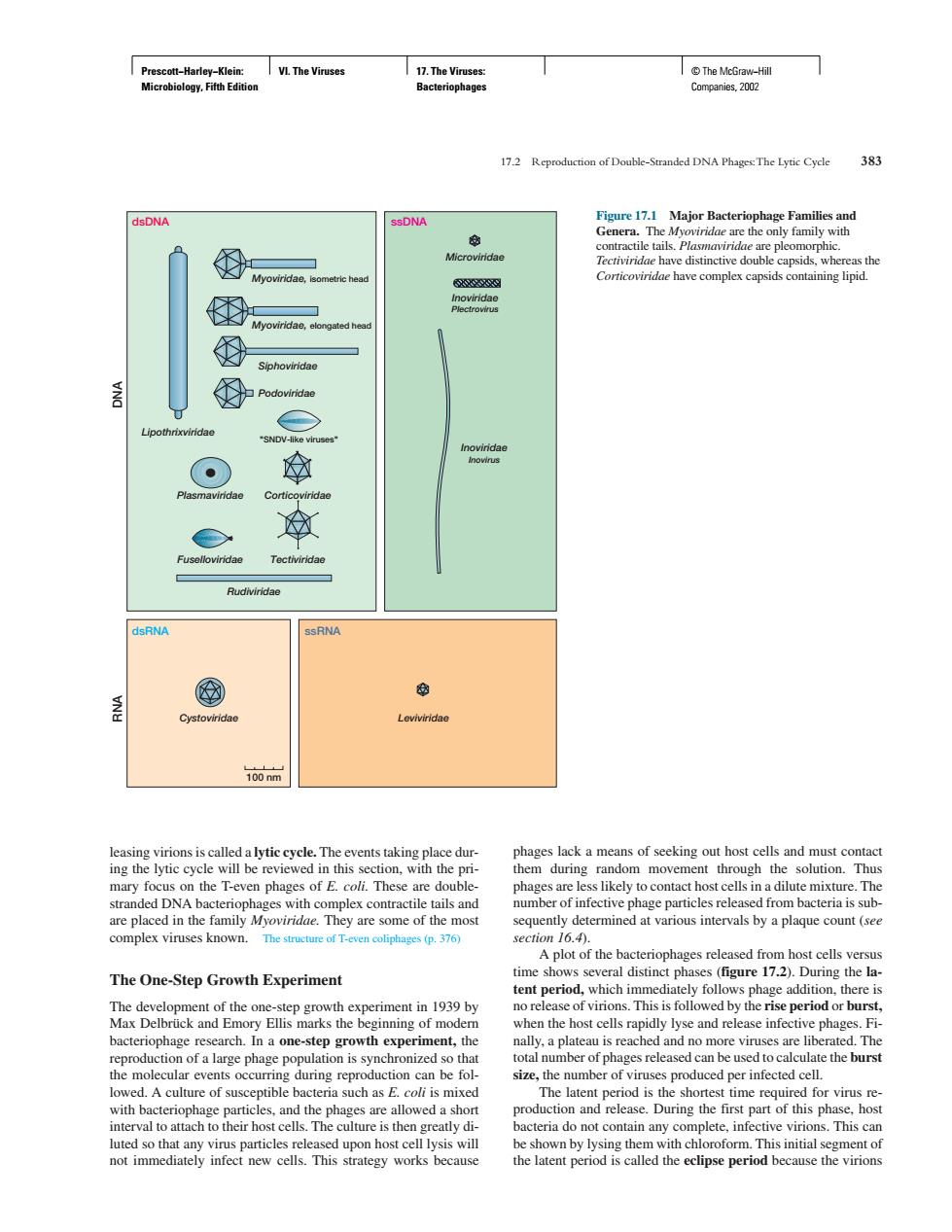正在加载图片...

I VL The Viruse n 172 Reproduction of Double-Standed DNA Phages The Lytic Cyde 383 dsDNA SSDNA 幻 图 dsRNA SSRNA 100m squently determined at various intervals by a plaque count( The structure of l-even colplages (p.376) The One-Step Growth Experiment time er of mo en the host cells rapidly ly e and rel se int e mber or vin ch as F dperintfcctcdcel uted so that any not immediately infect new cells.This strategy works because the latent period is called the eclipse period because the virions Prescott−Harley−Klein: Microbiology, Fifth Edition VI. The Viruses 17. The Viruses: Bacteriophages © The McGraw−Hill Companies, 2002 leasing virions is called a lytic cycle. The events taking place during the lytic cycle will be reviewed in this section, with the primary focus on the T-even phages of E. coli. These are doublestranded DNA bacteriophages with complex contractile tails and are placed in the family Myoviridae. They are some of the most complex viruses known. The structure of T-even coliphages (p. 376) The One-Step Growth Experiment The development of the one-step growth experiment in 1939 by Max Delbrück and Emory Ellis marks the beginning of modern bacteriophage research. In a one-step growth experiment, the reproduction of a large phage population is synchronized so that the molecular events occurring during reproduction can be followed. A culture of susceptible bacteria such as E. coli is mixed with bacteriophage particles, and the phages are allowed a short interval to attach to their host cells. The culture is then greatly diluted so that any virus particles released upon host cell lysis will not immediately infect new cells. This strategy works because phages lack a means of seeking out host cells and must contact them during random movement through the solution. Thus phages are less likely to contact host cells in a dilute mixture. The number of infective phage particles released from bacteria is subsequently determined at various intervals by a plaque count (see section 16.4). A plot of the bacteriophages released from host cells versus time shows several distinct phases (figure 17.2). During the latent period, which immediately follows phage addition, there is no release of virions. This is followed by the rise period or burst, when the host cells rapidly lyse and release infective phages. Finally, a plateau is reached and no more viruses are liberated. The total number of phages released can be used to calculate the burst size, the number of viruses produced per infected cell. The latent period is the shortest time required for virus reproduction and release. During the first part of this phase, host bacteria do not contain any complete, infective virions. This can be shown by lysing them with chloroform. This initial segment of the latent period is called the eclipse period because the virions 17.2 Reproduction of Double-Stranded DNA Phages:The Lytic Cycle 383 dsDNA dsRNA Cystoviridae Leviviridae 100 nm Fuselloviridae Tectiviridae Rudiviridae Plasmaviridae Lipothrixviridae Microviridae Inoviridae Plectrovirus Inoviridae Inovirus Podoviridae Siphoviridae Myoviridae, elongated head Myoviridae, isometric head Corticoviridae DNA RNA ssDNA ssRNA "SNDV-like viruses" Figure 17.1 Major Bacteriophage Families and Genera. The Myoviridae are the only family with contractile tails. Plasmaviridae are pleomorphic. Tectiviridae have distinctive double capsids, whereas the Corticoviridae have complex capsids containing lipid